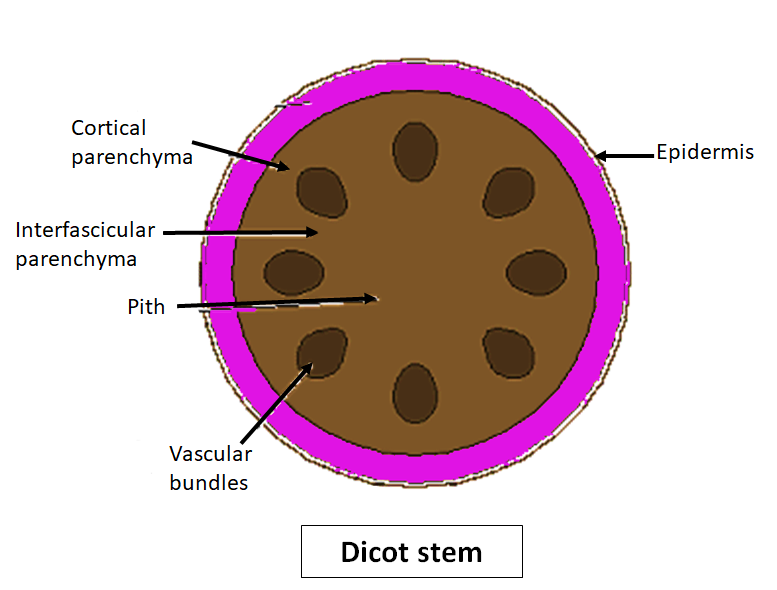
Vascular bundles in dicot stems are:
(a)Open, collateral, endarch
(b)Closed, collateral, endarch
(c)Open, collateral, exarch
(d)Closed, collateral, exarch
Answer
483.3k+ views
Hint: Vascular bundles are a collection of tube-like tissues that flow through plants and are a part of the transport system, transporting critical substances to various parts of the plant. The vascular bundle consists of two forms: xylem and phloem.
Complete step-by-step answer:
Xylem transports water and nutrients and phloem transports organic molecules, these, in addition, will include supporting and protective tissues, phloem on the outer surface, and xylem on the inside. Because of the presence of cambium the vascular bundles of dicot stem are open. In the dicot stem, vascular bundles are arranged in a ring around the pith and the pith is concentrated at the core of the stem.

Xylem is described as an endarch and is used when there is more than one strand of primary xylem in a stem or root. The xylem develops from the inside towards the periphery, i.e., centrifugally. The protoxylem is closest to the center of the stem or root and the metaxylem closest to the periphery of the stem. The stems of dicot plants typically have endarch development and the roots are normally considered to have exarch development. Closed vascular bundles are present in monocots as they lack cambium. Vascular bundles in monocot stems are closed, collateral, and endarch.
So, the correct answer is ‘open, collateral, endarch’.
Note: The stems of dicot plants have a well-defined epidermis with a cuticle, a layer of dermis along with multicellular stem hair. Examples are sunflower and Cucurbita. Cambium separates xylem and phloem, and all the tissue from the cambium layer outward is considered bark, while all the tissue inside the cambium layer to the center of the tree is wood.
Complete step-by-step answer:
Xylem transports water and nutrients and phloem transports organic molecules, these, in addition, will include supporting and protective tissues, phloem on the outer surface, and xylem on the inside. Because of the presence of cambium the vascular bundles of dicot stem are open. In the dicot stem, vascular bundles are arranged in a ring around the pith and the pith is concentrated at the core of the stem.

Xylem is described as an endarch and is used when there is more than one strand of primary xylem in a stem or root. The xylem develops from the inside towards the periphery, i.e., centrifugally. The protoxylem is closest to the center of the stem or root and the metaxylem closest to the periphery of the stem. The stems of dicot plants typically have endarch development and the roots are normally considered to have exarch development. Closed vascular bundles are present in monocots as they lack cambium. Vascular bundles in monocot stems are closed, collateral, and endarch.
So, the correct answer is ‘open, collateral, endarch’.
Note: The stems of dicot plants have a well-defined epidermis with a cuticle, a layer of dermis along with multicellular stem hair. Examples are sunflower and Cucurbita. Cambium separates xylem and phloem, and all the tissue from the cambium layer outward is considered bark, while all the tissue inside the cambium layer to the center of the tree is wood.
Recently Updated Pages
Can anyone list 10 advantages and disadvantages of friction

What are the Components of Financial System?

How do you arrange NH4 + BF3 H2O C2H2 in increasing class 11 chemistry CBSE

Is H mCT and q mCT the same thing If so which is more class 11 chemistry CBSE

What are the possible quantum number for the last outermost class 11 chemistry CBSE

Is C2 paramagnetic or diamagnetic class 11 chemistry CBSE

Trending doubts
Which is not a source of freshwater 1 Glaciers and class 11 chemistry CBSE

10 examples of friction in our daily life

The correct order of melting point of 14th group elements class 11 chemistry CBSE

Difference Between Prokaryotic Cells and Eukaryotic Cells

One Metric ton is equal to kg A 10000 B 1000 C 100 class 11 physics CBSE

What is the specific heat capacity of ice water and class 11 physics CBSE




